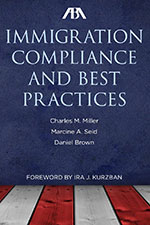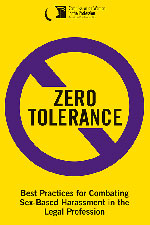VERDICT: Touchdown!
 Immigration Compliance and Best Practices
Immigration Compliance and Best Practices
By Charles M. Miller, Marcine A. Seid & Daniel Brown (Chicago, IL: ABA, 2018). 452 pgs. $139.95. Order, www.americanbar.org/products.com.
Reviewed by Nilesh Patel
In Immigration Compliance and Best Practices, published in 2018 by the American Bar Association, the authors provide lawyers with the information they need to “proactively implement programs for current and future immigration law compliance” and to help them create more than an “off-the-shelf” compliance approach. The authors state this is a relatively new subspecialty of immigration law, with few compliance resources. They fill that gap with a resource that should help in-house counsel, risk management and compliance, human resources, employment law, and business law practitioners spot major risks and avoid serious compliance problems when it comes to the recruitment of and hiring of employees who are citizens or permanent residents or with work visas. At the same time, the book makes clear that a skilled immigration lawyer will be a necessary partner to successfully navigate the risks.
Right from the introduction, the authors provide crucial guidance, warning that given the range of legal risks involved, employers should make immigration compliance an integral part of their risk management program. In addition, to mitigate or avoid potential legal liability, employers must consider the collateral consequences of possible criminal violations and should factor in consideration of nonimmigration statutes, such as the federal sentencing guidelines. I found this a valuable insight, informing readers to factor in a related issue they might have otherwise missed during the creation and implementation of a compliance program or when evaluating the defense or settlement of an enforcement action.
Want to Review a Book?
Please request a book and writing guidelines from Wisconsin Lawyer managing editor Karlé Lester, at klester@wisbar.org or (608) 250-6127. Reviewers may keep the book reviewed. Reviews of about 500 words are due within 45 days of receiving the book. Reviews are published, space permitting, in the order received and may be edited for length and clarity.
The book covers 10 major topics in a relatively short 300 pages. The topics range from employer liability and potential civil and criminal penalties, enforcement actions and legal basis, restrictions on technology and exports, managing immigration visa-based hiring, properly implementing employment verification requirements, avoiding unfair and discriminatory practices, using online employment verification programs for federal contractors, due diligence and compliance strategies, and developing an external audit process to proactively spot risks and also to mitigate penalties as a result of an enforcement action.
The book makes clear that as opposed to only reviewing immigration law-related statutes or case law, a proper understanding of this area also requires knowledge of the relevant enforcement agencies, their overlapping authority, and memoranda and guidance documents from these agencies. The book points to several guides, such as a guide to inspections and penalties for Form I-9 and a handbook for employers.
A small quibble is that the book provides an online link for these documents, but the link did not work. That said, the guides are likely easily found via an online search, if they are still publicly available from the administrative agency. Even if a particular guide is not available, the book once again provides an insight for lawyers to review the most current policy guidance issued by these agencies.
Reviewing this book greatly expanded my understanding of topics with which I thought I was already familiar, such as Form I-9 procedures and avoiding discrimination risks. Overall, I believe the book will prove to be an invaluable tool for spotting issues and creating general protections and policies for companies.
Nilesh Patel, U.W. 2002, is counsel at the Day Care Council of New York Inc., New York, N.Y. He is also the principal attorney at the Mahadev Law Group LLC. In both capacities, he advises business on employment and human resources matters.
 VERDICT: Touchdown!
VERDICT: Touchdown!
Punishment Without Crime: How Our Massive Misdemeanor System Traps the Innocent and Makes America More Unequal
By Alexandra Natapoff (New York, NY: Basic Books, 2018). 352 pgs. $27. Order, www.barnesandnoble.com.
Reviewed by Craig R. Johnson
Punishment Without Crime: How Our Massive Misdemeanor System Traps the Innocent and Makes America More Unequal, by Alexandra Natapoff, is an encyclopedic examination of the system(s) of misdemeanor justice in the United States – systems that, as the title implies, can inflict punishment far out of proportion to the behavior at which it is aimed.
Natapoff, a law professor at the University of California, Irvine, has conducted an exhaustive study of the myriad systems that regulate low-level illegal behavior across the country. Her first task is to recognize that even reaching a clean and consistent definition of “misdemeanor” is problematic. The definition varies and can have a big effect on the outcome of a particular situation – whether a defendant gets a jury trial, for example, or appointed counsel through a public defense system. One chapter examines the ways in which vastly different offenses, from OWI to vagrancy to domestic violence, fit into various systems of “misdemeanor” justice.
Natapoff also examines the policing of petty infractions and how it has negatively affected people of color, low-income people, and others without the power to effectively challenge what amounts to “assembly line” justice. She weaves the stories of individuals into the various chapters to illustrate the devastating effect that the system can have – even on innocent persons. For example, she tells the story of Tyrone Tomlin, who was arrested for a minor drug-paraphernalia violation and was held at Riker’s Island because he couldn’t afford bail and refused the 30-day sentence offered. At Riker’s he was assaulted and ended up with an eye injury that was still causing blurry eyesight months later. He was innocent and the charge eventually was dropped, but the system had already exacted its punishment.
In other chapters, Natapoff traces the history of the misdemeanor justice system’s role in keeping social order, particularly detailing the use of vagrancy laws to control the African-American population in the southern United States. Not only did such laws provide a source of essentially “neo-slave” labor for rent, they also saddled convicted individuals with various fees that help fund the system of oppression under which they suffered. Again, a devastating illustration is used – the story of Green Cottenham, an African-American man who was arrested for vagrancy and sentenced to six months of hard labor in Alabama. His “sentence” was then purchased by a coal company, and he was put to work in a mine. He died of tuberculosis before he completed his sentence – at age 22, in 1908.
The system of misdemeanor injustice has long existed in the shadowy corners of our courthouses. Because its targets are often powerless and neglected, its offenses petty and deemed unimportant, the shortcomings of the system do not get the attention they deserve. Natapoff’s book is a comprehensive examination of the problems and possible solutions for this crisis.
As she points out, progress has been made – vagrancy laws challenged, forced labor apparatus dismantled – because of the dogged advocacy of lawyers, activists, and grassroots organizations. A well-administered system of public defense can make a difference. Public defenders and private attorneys who take appointments to represent indigent defendants can make a big difference, but too often these systems are underfunded. Nonetheless, for novice and veteran lawyers alike, standing up in court and effectively fighting for a misdemeanor defendant can make a huge difference in the defendant’s life. Doing so won’t make the lawyer the subject of a TV show, a podcast, or a documentary, but as Natapoff reveals in her book, few causes in the practice of law are more noble.
Craig R. Johnson, U.W. 1994, practices criminal defense and labor law at Sweet and Associates, Milwaukee.
 VERDICT: It’s a Keeper
VERDICT: It’s a Keeper
Zero Tolerance: Best Practices for Combating Sex-Based Harassment in the Legal Profession
By Commission on Women in the Profession (Chicago, IL: ABA, 2018). 92 pgs. $49.95 ($39.97 for ABA members). Order, https://americanbar.org/products/.
Reviewed by Dianne Post
This short and practical book provides everything needed to set up an effective sexual harassment policy in a law firm. After the opening from Anita Hill, the authors outline the problem and legal framework. The prevalence of sexual harassment in law firms cannot be disputed (50 percent of women reportedly have experienced it and 75 percent think it is a problem), and the evidence for the negative effect it has on women and their careers is overwhelming.
The loss is not only to the women but to the legal profession as a whole. Although the problem was recognized 24 years ago, even today, only two states have adopted ABA Model Rule 8.4 to address it. Although this section of the book is short, the footnotes are devastating – defining the depth and breadth of the negative effects on individuals, workplaces, and society.
Next, the authors discuss current manifestations such as bullying and implicit bias. Bullying is often a precursor to sexual harassment, and research at the University of Arizona is ongoing. Harvard has an implicit bias test online that is very instructive (https://implicit.harvard.edu/implicit/takeatest.html).
Law firms pay a high price for sexual harassment, from lost productivity to compensatory and punitive damages. From Anita Hill to Christine Blasey Ford, the public shaming that comes with reporting sexual harassment endures. Recently a victim posted the following on her Facebook page: “When my money is taken, I’m a victim of robbery; when my car is taken, I’m a victim of car theft, when I’m assaulted, I’m a victim of assault; but when I’m raped, I’m an accuser.”
The book then moves into practical actions such as training and prevention, policy, complaint and reporting processes, investigation and anti-retaliation procedures, sanctions, and discipline. At first reading, I was a little aggravated about the time spent on the detail of the investigation procedure – after all we are lawyers and know how to do an investigation, don’t we? But considering how poorly these investigations have been done in the past, perhaps such a step-by-step outline is necessary.
The book concludes with a discussion of sanctions, that is, informal and formal in-firm procedures and (if those are not successful) legal action. The appendices give samples of policy and progressive discipline. Thus, no firm has an excuse not to have a policy and a procedure for dealing with complaints of sexual harassment. The ones in the book can be adapted and used.
As lawyers, we should set the standards, not hide behind outdated power structures and perpetuate abuse. The legal profession has a special obligation to uphold the rule of law, especially in law firms. Let’s do what we should be doing – lead.
Dianne Post, U.W. 1979, is an international human rights lawyer. She practiced family law in Arizona for 18 years, mostly representing battered women and molested children, and then in 1998 began doing international work mainly on gender-based violence.
